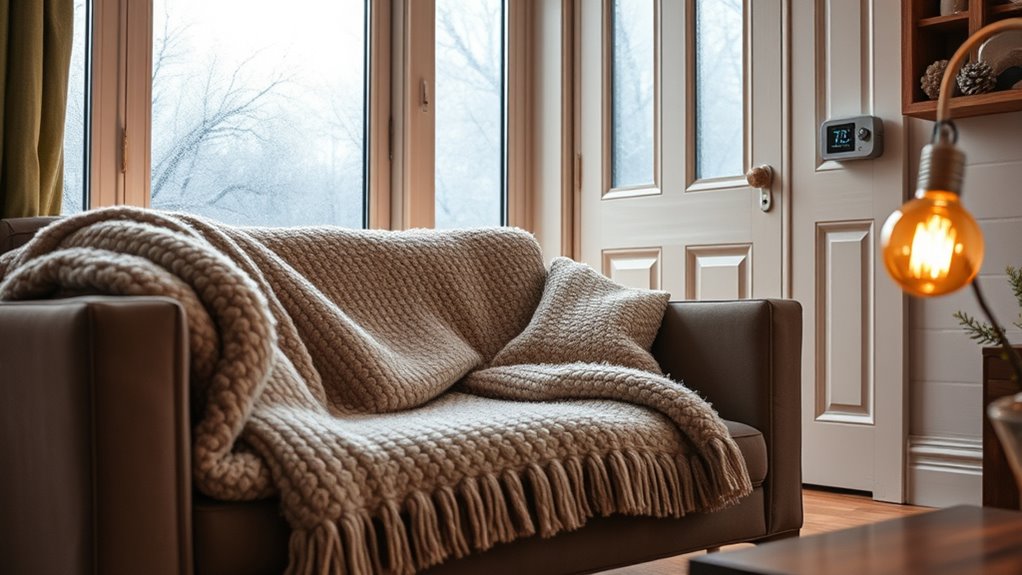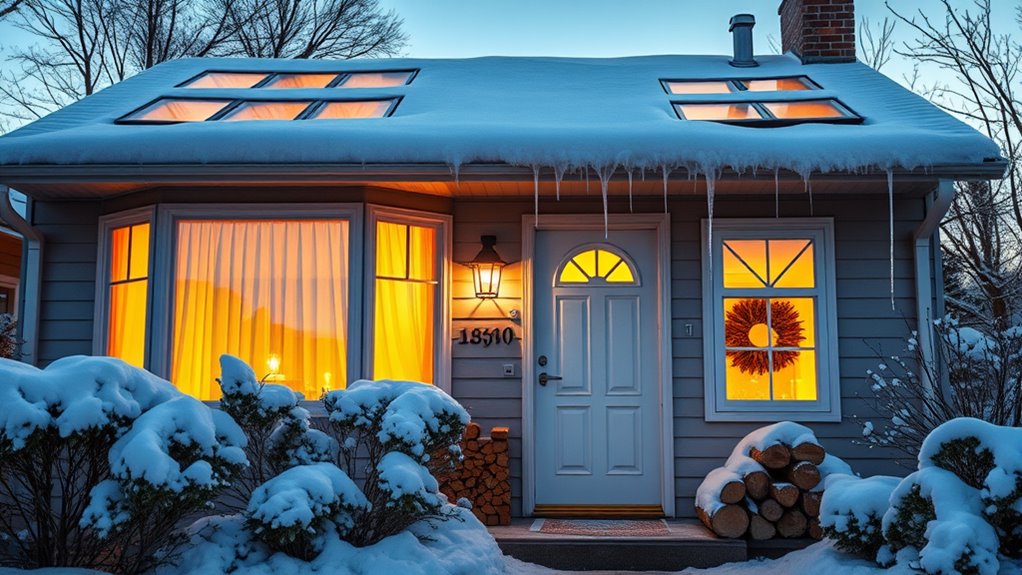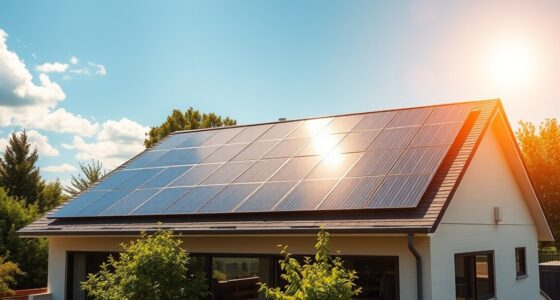To save energy this winter, start by sealing drafts around windows and doors, and add insulation to your attic, walls, and floors. Set your thermostat to 68-70°F and use programmable or zone heating to stay cozy efficiently. Switch to LED lighting, utilize natural sunlight, and insulate your water heater and pipes. Opt for energy-efficient appliances, monitor usage, and consider upgrades. Keep exploring these tips to make your home even more energy-smart this season.
Key Takeaways
- Seal drafts around windows and doors and add storm windows to minimize heat loss.
- Optimize your heating system with programmable thermostats and zone heating for efficiency.
- Insulate water heaters and exposed pipes to prevent heat loss and freezing issues.
- Switch to LED lighting, utilize natural daylight, and install timers or dimmers to reduce lighting energy use.
- Conduct energy audits, unplug unused electronics, and upgrade to Energy Star appliances to monitor and cut energy consumption.

As winter approaches, preparing your home to stay warm and save energy is vital. You want to make sure heat stays inside and your energy bills don’t spiral out of control. Start by checking your insulation. Make sure the attic, walls, and floors are well-insulated. Proper insulation keeps heat from escaping, so you stay warmer without overworking your furnace. Next, seal any drafts around windows and doors with caulk or weatherstripping. This simple step can reduce heat loss by 10-20%, making a noticeable difference. If your windows are older or drafty, consider installing storm windows to cut heat loss by up to 50%. It’s an investment that pays off through lower heating costs. Don’t forget to clean your gutters and downspouts. Clear water flow prevents ice dams, which can cause damage and block heat from escaping. Meanwhile, schedule a professional furnace inspection to guarantee your heating system runs efficiently all winter long. A well-maintained furnace uses less energy and keeps your home comfortable.
When it comes to space heating, adjust your thermostat to a comfortable 68-70°F when you’re home. Lower it when you’re away or sleeping to conserve energy. If you have radiant floor heating, use it in frequently used areas for efficient warmth. For less-used rooms, zone heating with space heaters provides targeted comfort without wasting energy on unoccupied spaces. Installing a programmable thermostat lets you automate temperature adjustments, guaranteeing your home is warm when needed and cooler when not. Protect exposed pipes in unheated areas by insulating them; this prevents freezing and potential plumbing issues during cold snaps. Additionally, incorporating AI in Education solutions like intelligent tutoring systems can help optimize heating schedules based on occupancy patterns, further saving energy during times when the home is unoccupied.
Lighting is another easy way to cut energy costs. Replace traditional bulbs with LED lights—they consume at least 75% less energy and last longer. Use natural daylight during the day to brighten your home and reduce the need for artificial lighting. Task lighting helps focus illumination where you need it most, while installing dimmers and timers gives you control over light levels and schedules, saving energy when full brightness isn’t necessary. For outdoor lighting, opt for solar-powered options that don’t add to your electricity bill.
Don’t overlook water heating. Insulate your water heater with a thermal blanket and lower its temperature to 120°F to cut standby heat loss and energy use. If you’re considering a new system, an energy-efficient tankless water heater can make a significant difference. Regularly check for leaks and descale the unit to keep it running smoothly.
Finally, improve appliance efficiency by switching to Energy Star-rated appliances and using smart plugs to monitor energy consumption. Maintain appliances regularly and unplug electronics when not in use to eliminate standby power drain. Conduct a DIY energy audit by sealing air leaks around windows, doors, and ducts, and verify insulation levels. Use an energy meter to track your usage and identify inefficiencies. For thoroughness, consider a professional utility audit. These steps together create a detailed winter energy-saving plan, helping your home stay warm while keeping energy bills in check.
Frequently Asked Questions
How Can I Prevent Drafts Around Windows and Doors?
To prevent drafts around windows and doors, start by sealing gaps with weatherstripping or caulk. Use draft stoppers, door snakes, and door sweeps to block cold air. Add insulating curtains or thermal drapes for extra warmth. Consider installing storm windows or winter inserts for added insulation. Regularly inspect and replace worn seals, and check for air leaks using a candle or smoke test to keep your home cozy all winter.
What Are the Most Energy-Efficient Heating Options for Winter?
You want to know the most energy-efficient heating options for winter. Consider installing a geothermal heat pump, which uses the earth’s stable temperature to heat and cool your home efficiently. Air-source heat pumps are also great, providing both heating and cooling with high energy savings. Ductless mini-split systems are ideal for small spaces, and high-efficiency furnaces can boost your home’s warmth while lowering energy bills.
How Often Should I Service My Furnace for Optimal Efficiency?
You should service your furnace once a year for maximum efficiency and safety. The best time is early fall, giving you time to inspect, clean, and address any issues before winter hits. Regular maintenance, including filter changes and system checks, keeps your furnace running smoothly, saves energy, and prevents costly repairs. Scheduling with a qualified technician ensures your system performs well and stays reliable throughout the cold months.
Are Programmable Thermostats Worth the Investment?
You’re wondering if programmable thermostats are worth the investment. They are, especially if you want to save money on energy bills and reduce environmental impact. With an average annual saving of around $180, they pay for themselves within a few years. Plus, they’re affordable, easy to program, and compatible with most systems, making them a practical choice for long-term energy efficiency and convenience in your home.
How Can I Improve Insulation in Existing Walls?
To improve insulation in your existing walls, start with an energy audit to identify gaps. Consider non-invasive options like blown-in cellulose or spray foam, which fill cavities and seal air leaks without drywall removal. For better results, guarantee your home is air-sealed first. If needed, drill small holes to fill wall cavities, then seal them. These upgrades will boost energy efficiency, reduce heat loss, and keep your home warmer.
Conclusion
As you cozy up by the flickering fire, remember that a few simple steps can keep your home warm without draining your wallet. Picture your heated sanctuary, snug and inviting, while you save energy and cut costs. With these easy fixes, you’ll enjoy a toasty winter, wrapped in comfort and peace of mind. Embrace these tips, and let your home become a warm haven against the winter chill—efficient, cozy, and budget-friendly all season long.










